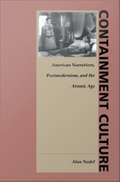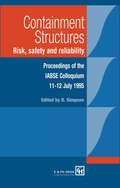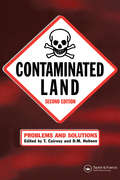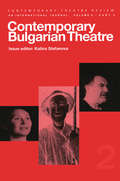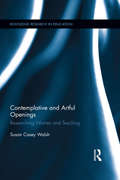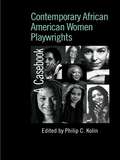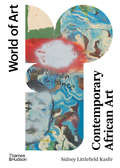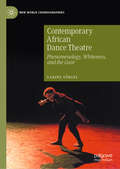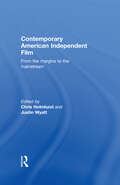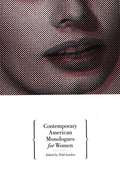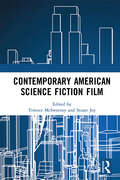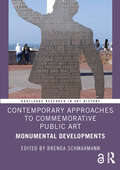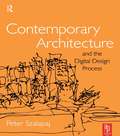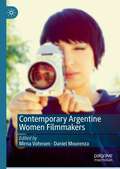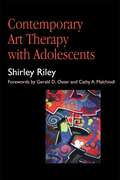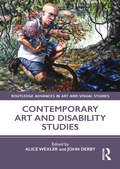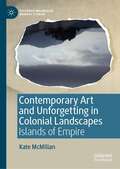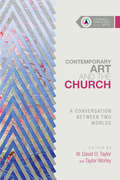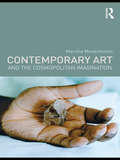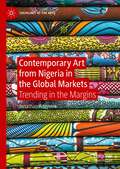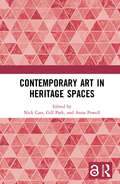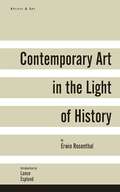- Table View
- List View
Containment Culture: American Narratives, Postmodernism, and the Atomic Age
by Alan NadelAlan Nadel provides a unique analysis of the rise of American postmodernism by viewing it as a breakdown in Cold War cultural narratives of containment. These narratives, which embodied an American postwar foreign policy charged with checking the spread of Communism, also operated, Nadel argues, within a wide spectrum of cultural life in the United States to contain atomic secrets, sexual license, gender roles, nuclear energy, and artistic expression. Because these narratives were deployed in films, books, and magazines at a time when American culture was for the first time able to dominate global entertainment and capitalize on global production, containment became one of the most widely disseminated and highly privileged national narratives in history. Examining a broad sweep of American culture, from the work of George Kennan to Playboy Magazine, from the movies of Doris Day and Walt Disney to those of Cecil B. DeMille and Alfred Hitchcock, from James Bond to Holden Caulfield, Nadel discloses the remarkable pervasiveness of the containment narrative. Drawing subtly on insights provided by contemporary theorists, including Baudrillard, Foucault, Jameson, Sedgwick, Certeau, and Hayden White, he situates the rhetoric of the Cold War within a gendered narrative powered by the unspoken potency of the atom. He then traces the breakdown of this discourse of containment through such events as the Bay of Pigs invasion and the Free Speech Movement at Berkeley, and ties its collapse to the onset of American postmodernism, typified by works such as Catch-22 and The Man Who Shot Liberty Valence. An important work of cultural criticism, Containment Culture links atomic power with postmodernism and postwar politics, and shows how a multifarious national policy can become part of a nation's cultural agenda and a source of meaning for its citizenry.
Containment Structures: Proceedings of the IABSE Henderson Colloquium
by B. SimpsonThis book brings together contributions from some of the leading researchers and practising engineers in the field of silos and containment structures, and is derived from a specially invited colloquium on the subject. As well as case studies, it includes reviews dealing with safety and risk in design and operation of these structures.
Contaminated Land: Problems and Solutions, Second Edition
by Griselda PollockContaminated land is a problem both in the short and long term as it cannot be used without remediation. The investigation and analysis of the problem, along with the legal responsibilities surrounding the issues, continue to present difficulties to those wishing to use or develop a contaminated site. Since publication of the 1st edition, the area
Contemp Bugarian Theatre 2
by StefanovaFirst Published in 1998. Routledge is an imprint of Taylor & Francis, an informa company.
Contemplating the Ancients: Aesthetic and Social Issues in Early Chinese Portraiture
by Audrey SpiroThis title is part of UC Press's Voices Revived program, which commemorates University of California Press’s mission to seek out and cultivate the brightest minds and give them voice, reach, and impact. Drawing on a backlist dating to 1893, Voices Revived makes high-quality, peer-reviewed scholarship accessible once again using print-on-demand technology. This title was originally published in 1990.
Contemplative and Artful Openings: Researching Women and Teaching (Routledge Research in Education #193)
by Susan Casey WalshHighlighting an arts-based inquiry process that involves contemplation, mindful awareness, and artful writing, this book explores women’s difficult experiences in teaching. It weaves a strong autobiographical thread with artifacts from several research projects with female teachers. By linking innovative approaches to research that involve visual images and poetic writing with feminist poststructuralist theories and Buddhist-inspired practices, Walsh offers new understandings about what it means to be critical in research and teaching—and also what transformation, both social and personal, might entail.
Contemporary African American Women Playwrights: A Casebook (Casebooks on Modern Dramatists)
by Philip C. Kolin'The impressive array of scholars gathered in this collection, all experts in the field, read the plays with nuance and situate them deftly within their cultural and historical contexts. Scholars of contemporary theater and drama and of African American literature will find value in this engaging collection.' – Choice 'For students and scholars of American theatre and drama generally and African American theatre and drama most particularly, this is an extremely valuable critical source.' – Harry Elam, Stanford University, USA In the last fifty years, American and World theatre has been challenged and enriched by the rise to prominence of numerous female African American dramatists. Contemporary African American Women Playwrights is the first critical volume to explore the contexts and influences of these writers, and their exploration of black history and identity through a wealth of diverse, courageous and visionary dramas. Kolin compiles a wealth of new essays, comprising: Yale scholar David Krasner on the dramatic legacy of Lorraine Hansberry, Zora Neale Hurston, Marita Bonner and Georgia Douglas Johnson individual chapters devoted to: Alice Childress, Sonia Sanchez, Adrienne Kennedy, Ntozake Shange, Pearl Cleage, Aishah Rahman, Glenda Dickerson, Anna Deavere Smith and Suzan Lori-Parks an essay and accompanying interview with Lynn Nottage comprehensive discussion of attendant theatrical forms, from choreopoems and surrealistic plays, to documentary theatre and civil rights dramas, and their use in challenging racial and gender hierarchies. Contributors: Brandi Wilkins Catanese, Soyica Diggs, James Fisher, Freda Scott Giles, Joan Wylie Hall, Philip C. Kolin, David Krasner, Sandra G. Shannon, Debby Thompson, Beth Turner and Jacqueline Wood.
Contemporary African Art: Second Edition (World of Art #0)
by Sidney Littlefield KasfirA revised edition of this seminal title, surveying the diverse, ever-evolving field of contemporary African art from the 1950s to today, illustrated in color throughout. Contemporary African art has grown out of the diverse histories and cultural heritage of the African continent and its diaspora. It is not characterized by one particular style, technique, or theme, but by a bricolage-like attitude toward art making, incorporating and building upon the structures from which older, pre- colonial and colonial genres were made. In this revised and updated edition of Contemporary African Art, Sidney Littlefield Kasfir examines the major themes, developments, and accomplishments in African art of the twentieth and twenty-first centuries. Organized thematically, the book includes new chapters on the history of African photography and the growth of the global art market, alongside significant discussions of patronage, mediation, artistic training, and national and diaspora identities. Generously illustrated throughout, including work by artists such as El Anatsui, Yinka Shonibare, William Kentridge, and Ibrahim El-Salahi, the book draws on interviews with many contemporary artists and art world professionals. Contemporary African Art is a fascinating, comprehensive survey of art from the African continent and its global diaspora.
Contemporary African Dance Theatre: Phenomenology, Whiteness, and the Gaze (New World Choreographies)
by Sabine SörgelThis book is the first to consider contemporary African dance theatre aesthetics in the context of phenomenology, whiteness, and the gaze. Rather than a discussion of African dance per se, the author challenges hegemonic perceptions of contemporary African dance theatre to interrogate the extent to which white supremacy and privilege weave through capitalist necropolitics and determine our perception of contemporary African dance theatre today. Multiple aesthetic strategies are discussed throughout the book to account for the affective experience of ‘un-suturing’ that touches white spectatorship and colonial guilt at their core. The critical analysis covers a broad range of dance choreography by artists from the Democratic Republic of Congo, Ivory Coast, South Africa, Canada, Europe, and the US as they travel, create, and show their works internationally to global audiences to contest racial divides and white supremacist politics.
Contemporary American Independent Film: From the Margins to the Mainstream
by Chris Holmlund Justin WyattFrom Easy Rider to The Blair Witch Project, this book is a comprehensive examination of the independent film scene. Exploring the uneasy relationship between independent films and the major studios, the contributors trace the changing ideas and definitions of independent cinema, and the diversity of independent film practices. They consider the ways in which indie films are marketed and distributed, and how new technologies such as video, cable and the internet, offered new opportunities for filmmakers to produce and market independent films. Turning to the work of key auteurs such as John Sayles and Haile Gerima, contributors ask whether independent filmmakers can also be stars, and consider how indie features like Boys Don't Cry and Shopping for Fangs address issues of gender, sexuality and ethnicity normally avoided by Hollywood. For all students of film studies and American studies, this cultural journey through independent film history will be an absolute must read.
Contemporary American Monologues for Women
by Todd LondonAudition monologues for female characters selected from recent works by American playwrights including Tony Kushner, Jon Robin Baitz, Constance Congdon, Paula Vogel, Donald Margulies, Emily Mann, Eric Bogosian, Nicky Silver, and others. Unique to the TCG monologue series is a bibliography of other works by the playwrights included.
Contemporary American Science Fiction Film
by Terence McSweeneyContemporary American Science Fiction Film explores and interrogates a diverse variety of popular and culturally relevant American science fiction films made in the first two decades of the new millennium, offering a ground-breaking investigation of the impactful role of genre cinema in the modern era. Placing one of the most popular and culturally resonant American film genres broadly within its rich social, historical, industrial, and political context, the book interrogates some of the defining critical debates of the era via an in-depth analysis of a range of important films. An international team of authors draw on case studies from across the science fiction genre to examine what these films can tell us about the time period, how the films themselves connect to the social and political context, how the fears and anxieties they portray resonate beyond the screen, and how the genre responds to the shifting coordinates of the Hollywood film industry. Offering new insights and perspectives on the cinematic science fiction genre, this volume will appeal primarily to scholars and students of film, television, cultural and media studies, as well as anyone interested in science fiction and speculative film.
Contemporary Approaches to Commemorative Public Art: Monumental Developments (Routledge Research in Art History)
by Brenda SchmahmannIn this collection, a diverse range of international contributors examine commemorative monuments from the late twentieth and twenty-first centuries. The book reveals how those monuments enable new perspectives and understanding of histories as well as a heightened involvement of viewers through not simply their subject matter but also, most crucially, their actual form and design. While some contributors explore new approaches to the art of commemoration that artists and designers have deployed in recent monuments, others examine how artists have undertaken creative engagements with historical statuary and sites, using these interventions to offer critique and commentary. Additionally, the contributions consider the impact of political change on ways in which an inherited commemorative landscape is interpreted and negotiated. Questions considered by the contributions include: How might new monuments be shaped and how might they function differently from those of the past? Is there a place for portraiture in the contemporary commemorative landscape? Should commemorative monuments be envisaged as permanent fixtures or are temporary approaches more viable? How effectively have artists disrupted the meanings of historical monuments and sites through installation, performance, video and other media? How has political change played out at historical sites, affecting how commemorative monuments from prior dispensations are understood in the 2020s?This collection will be of value to researchers in Art History, Visual Studies and Heritage Studies, as well as scholars in all disciplines and fields who are interested in public art, public memory and the politics of commemoration.
Contemporary Architecture and the Digital Design Process
by Peter SzalapajContemporary Architecture and the Digital Design Process introduces the reader to new developments in the computer modelling of design form in contemporary architectural practice through a series of detailed case studies. The book illustrates how evolving design practices use and exploit the potential of new computing technologies in a wide range of areas and application.A central thesis of this book is that technology follows design demand, rather than design adjusting to available new technology. Designers are not merely passive recipients of prescribed computing tools and techniques. Instead, they are increasingly able to express their intuitive design ideas through the rational medium of computing.The book features several contemporary building projects, each of which introduces a range of CAD and computing issues based upon the work of creative architectural and engineering design practices. These include the offices of Frank O. Gehry, Peter Cook and Colin Fournier, Anthony Hunt Associates, Peter Hubner, Szyskowitz-Kowalski, and Faulkner Brown. All these examples show what architects need to know and the skills they need to acquire to use advanced CAD technology.
Contemporary Argentine Women Filmmakers
by Mirna Vohnsen Daniel MourenzaThis edited volume offers a wide-ranging picture of Argentine women filmmakers’ contribution to the film industry from the 1980s to the present by bringing together the work of highly acclaimed and emerging directors. Through thirteen critical essays by leading scholars in the field of Argentine cinema, the book acknowledges that contemporary women filmmakers have transformed the cinema of Argentina by questioning, challenging and debunking hegemonic patriarchal systems of representation. With a focus on women’s voices and experiences, the contributions redress both the under-representation of women and girls onscreen and the perpetuation of stereotypes, while exploring the innovative aesthetics used by these filmmakers.
Contemporary Art Therapy with Adolescents
by Shirley Riley Cathy A MalchiodiContemporary Art Therapy with Adolescents offers practical and imaginative solutions to the multifaceted challenges that clinicians face when treating young people. The author fuses the contemporary theories of clinical treatment with the creative processes of art therapy to arrive at a synthesis which yields successful outcomes when working with adolescents. Clinicians of allied disciplines, particularly art therapists, will find practical suggestions for using imagery to enrich their relationships with teenaged clients. The process of using art-making therapeutically, and the challenges of applying creativity in the current mental health world, are explored. Shirley Riley reviews current theories on adolescent development and therapy, and emphasizes the primary importance of relying on the youths' own narrative in the context of their social and economic backgrounds. She has found this approach preferential to following pre-designed assessment directives as a primary function of art therapy. Family, group and individual treatment are examined, as is the adolescent's response to short- and long-term treatment in residential and therapeutic school settings. The book is firmly rooted in Riley's clinical experience of working with this age group, and her proven ability to combine contemporary theories of adolescent treatment with inventive and effective art expressions.
Contemporary Art Therapy with Adolescents
by Shirley RileyContemporary Art Therapy with Adolescents offers practical and imaginative solutions to the multifaceted challenges that clinicians face when treating young people. The author fuses the contemporary theories of clinical treatment with the creative processes of art therapy to arrive at a synthesis which yields successful outcomes when working with adolescents. Clinicians of allied disciplines, particularly art therapists, will find practical suggestions for using imagery to enrich their relationships with teenaged clients. The process of using art-making therapeutically, and the challenges of applying creativity in the current mental health world, are explored.Shirley Riley reviews current theories on adolescent development and therapy, and emphasizes the primary importance of relying on the youths' own narrative in the context of their social and economic backgrounds. She has found this approach preferential to following pre-designed assessment directives as a primary function of art therapy. Family, group and individual treatment are examined, as is the adolescent's response to short- and long-term treatment in residential and therapeutic school settings. The book is firmly rooted in Riley's clinical experience of working with this age group, and her proven ability to combine contemporary theories of adolescent treatment with inventive and effective art expressions.
Contemporary Art and Capitalist Modernization: A Transregional Perspective (Routledge Advances in Art and Visual Studies)
by Octavian EsanuThis book addresses the art historical category of "contemporary art" from a transregional perspective, but unlike other volumes of its kind, it focuses in on non-Western instantiations of "the contemporary." The book concerns itself with the historical conditions in which a radically new mode of artistic production, distribution, and consumption – called "contemporary art" – emerged in some countries of Eastern Europe, the post-Soviet republics of the USSR, India, Latin America, and the Middle East, following both local and broader sociopolitical processes of modernization and neoliberalization. Its main argument is that one cannot fully engage with the idea of the "global contemporary" without also paying careful attention to the particular, local, and/or national symptoms of the contemporary condition. Part I is methodological and theoretical in scope, while Part II is historical and documentary. For the latter, a number of case studies address the emergence of the category "contemporary art" in the context of Lebanon, Egypt, India, Hungary, Slovenia, Croatia, Bosnia and Herzegovina, Armenia, and Moldova. The book will be of interest to scholars working in art history, globalism, cultural studies, and postcolonial studies.
Contemporary Art and Disability Studies (Routledge Advances in Art and Visual Studies)
by Alice Wexler John DerbyThis book presents interdisciplinary scholarship on art and visual culture that explores disability in terms of lived experience. It will expand critical disability studies scholarship on representation and embodiment, which is theoretically rich, but lacking in attention to art. It is organized in five thematic parts: methodologies of access, agency, and ethics in cultural institutions; the politics and ethics of collaboration; embodied representations of artists with disabilities in the visual and performing arts; negotiating the outsider art label; and first-person reflections on disability and artmaking. This volume will be of interest to scholars who study disability studies, art history, art education, gender studies, museum studies, and visual culture.
Contemporary Art and Unforgetting in Colonial Landscapes: Islands of Empire (Palgrave Macmillan Memory Studies)
by Kate McMillanThis book explores the work of artists based in the global south whose practices and methods interrogate and explore the residue of Empire. In doing so, it highlights the way that contemporary art can assist in the un-forgetting of colonial violence and oppression that has been systemically minimized. The research draws from various fields including memory studies; postcolonial and decolonial strategies of resistance; activism; theories of the global south; the intersection between colonialism and the Anthropocene, as well as practice-led research methodologies in the visual arts. Told through the author’s own perspective as an artist and examining the work of Julie Gough, Yuki Kihara, Megan Cope, Yhonnie Scarce, Lisa Reihana and Karla Dickens, the book develops a number of unique theories for configuring the relationship between art and a troubled past.
Contemporary Art and the Church: A Conversation Between Two Worlds (Studies in Theology and the Arts)
by W. David Taylor Taylor WorleyContemporary Art and the Church
Contemporary Art and the Cosmopolitan Imagination
by Marsha MeskimmonContemporary Art and the Cosmopolitan Imagination explores the role of art in conceiving and reconfiguring the political, ethical and social landscape of our time. Understanding art as a vital form of articulation, Meskimmon argues that artworks do more than simply reflect and represent the processes of transnational and transcultural exchange typical of the global economy. Rather, art can change the way we imagine, understand and engage with the world and with others very different than ourselves. In this sense, art participates in a critical dialogue between cosmopolitan imagination, embodied ethics and locational identity. The development of a cosmopolitan imagination is crucial to engendering a global sense of ethical and political responsibility. By materialising concepts and meanings beyond the limits of a narrow individualism, art plays an important role in this development, enabling us to encounter difference, imagine change and make possible the new. This book asks what it means to inhabit a globalized world – how we might literally and figuratively make ourselves cosmopolitans, ‘at home’ everywhere. Contemporary art provides a space for this enquiry. Contemporary Art and the Cosmopolitan Imagination is structured and written through four ‘architectonic figurations’ – foundation, threshold, passage and landing – which simultaneously reference the built environment and the transformative structure of knowledge-systems. It offers a challenging new direction in the current literature on cosmopolitanism, globalisation and art.
Contemporary Art from Nigeria in the Global Markets: Trending in the Margins (Sociology of the Arts)
by Jonathan AdeyemiThis book brings together from four years of study on Nigerian contemporary art's internationalization. The monograph integrates voices of African (Nigerian) artists and art market players into the growing discourse on the emerging art markets in the global South. It explores the logic of competition and dynamics of power relations in the global markets, focusing on the internationalization of contemporary art forms from peripheral regions. The book confirms that the internationalization of contemporary art form from Nigeria is limited due to systematic marginalization in the artistic field, which in this case based on postcolonialism, and debilitating socio-economic factors such as outmoded art education, unstructured support system and weak mechanism for local validation, and an inefficient political framework for art governance.It will therefore be useful to students and researchers in the sociology of art, art market studies, art history and culture polity.
Contemporary Art in Heritage Spaces
by Gill Cass Anna Powell Nick ParkContemporary Art in Heritage Spaces considers the challenges that accompany an assessment of the role of contemporary art in heritage contexts, whilst also examining ways to measure and articulate the impact and value of these intersections in the future. Presenting a variety of perspectives from a broad range of creative and cultural industries, this book examines case studies from the past decade where contemporary art has been sited within heritage spaces. Exploring the impact of these instances of intersection, and the thinking behind such moments of confluence, it provides an insight into a breadth of experiences – from curator, producer, and practitioner to visitor – of exhibitions where this juncture between contemporary art and heritage plays a crucial and critical role. Themes covered in the book include interpretation, soliciting and measuring audience responses, tourism and the visitor economy, regeneration agendas, heritage research, marginalised histories, and the legacy of exhibitions. Contemporary Art in Heritage Spaces will be essential reading for academics and students engaged in the study of museum and heritage studies and contemporary art around the globe. Museum practitioners and artists should also find much to interest them within the pages of this volume. Chapter 9 of this book is available for free in PDF format as Open Access from the individual product page at www.routledge.com. It has been made available under a Creative Commons Attribution-Non Commercial-No Derivatives 4.0 license
Contemporary Art in the Light of History (Artists And Art Ser.)
by Deborah Rosenthal Erwin Rosenthal Lance EsplundErwin Rosenthal's Contemporary Art in the Light of History, originally published in 1971, is a small masterpiece of writing on the art of the twentieth century. A scholar of medieval art by training and a prominent antiquarian bookseller, Rosenthal, who died in l981, was equally entranced by modern art, particularly abstraction. His three linked essays in this book--"Contemporary Art in the Light of History," "Art and Technology," and "Art Theories and Manifestos, Old and New"--set out a path to understanding modern art through its affinities with the art of the past.Rosenthal engages with some of the enduring aesthetic questions: How do new forms and new artistic vocabularies respond to the deepest human needs and impulses? What is the relationship between artistic theory and artistic expression? Nicolas Poussin's mythological landscapes, Paul Klee's graphic abstractions, Bridget Riley's op-art compositions--these and many other examples from centuries of painting, sculpture, poetry, and music take us, in these pages, on a fascinating cultural journey with a sophisticated and lucid guide. Rosenthal's explorations of the theory and practice of twentieth-century artists bring us directly into the minds and studios of modern artists. What is more, like his previous The Changing Concept of Reality in Art, already republished by Arcade, this book invites us into a great intimacy with the origins of art.
